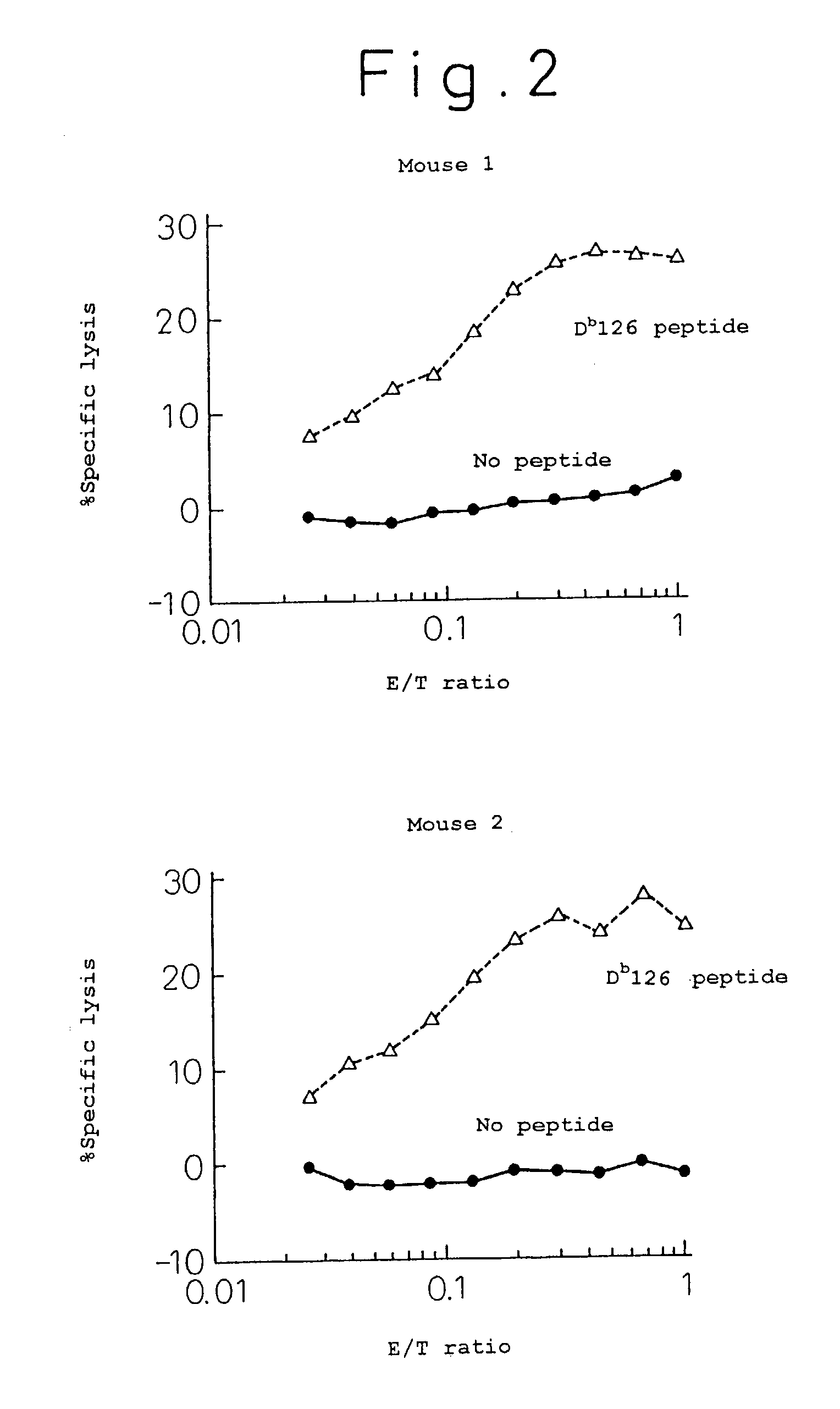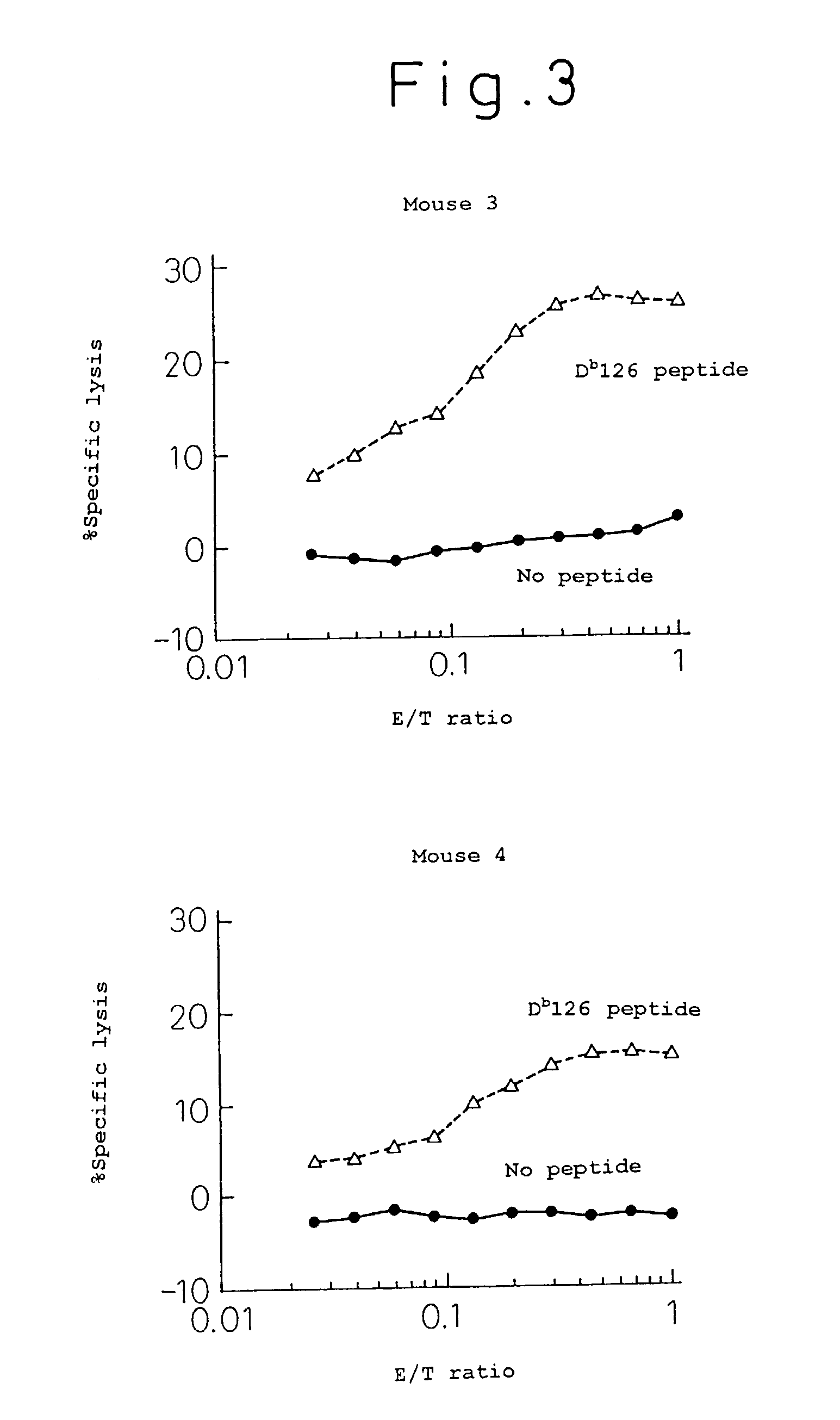Tumor antigen based on products of the tumor suppressor gene WT1
a tumor suppressor and antigen technology, applied in the field of tumor antigens, can solve problems such as unconfirmed
- Summary
- Abstract
- Description
- Claims
- Application Information
AI Technical Summary
Benefits of technology
Problems solved by technology
Method used
Image
Examples
example 1
[0053]One hundred μg of the Db 126 peptide, 200 μg of porcine lactate dehydrogenase and 0.5 ml of Freund's incomplete adjuvant were intraperitoneally injected to C57BL / 6 mice twice every week for immunization treatment. One week after the immunization treatment, the mouse spleen was extracted, from which suspensions of spleen cells were prepared. On the other hand, the irradiated spleen cells of the syngeneic mice pulsed with the Db 126 peptide were incubated with a solution containing 50 μg / ml peptide at 37° C. for 30 minutes, which was used as the antigen presenting cell.
[0054]The above immunized spleen cells and the irradiated spleen cells were co-cultured for 5 days to induce or prepare killer T cells. On the other hand, using the Europium labeled EL-4 cells (expressing Kb and Db) pulsed with the Db 126 peptide (incubated at 37° C. for 30 minutes with a 100 μg / ml peptide solution) as the target cell in a standard method, a killing assay was performed in the following procedure (...
example 2
[0059]Dendritic cells (DC) derived from the bone marrow of the C57BL / 6 mice were prepared in the following manner. According to the standard method, the bone marrow cells were cultured in the presence of GM-CSF to prepare bone marrow-derived dendritic cells (J. Exp. Med. 182: 255, 1995).
[0060]The dendritic cells cultured for 7 days, 10 μM OVAII (Ovalbumin II) and 1 μM Db 126 peptide were incubated for 3 hours and then washed.
[0061]Then, the above DC cells were intradermally injected to the foot pads and hands of C57BL / 6 mice, and on day 5 the lymph nodes were removed to prepare cell suspensions. On the other hand, the B7.1-RMA-S cells (RMA-S cells transfected with a gene encoding B7.1 which is a co-stimulatory molecule) pulsed with Db 126 and irradiated were prepared.
[0062]Then the above cell suspension derived from the relevant lymph node and the B7.1-RMA-S cells were mixed and cultured for in vitro restimulation.
[0063]Then, on day 5 after the in vitro restimulation, a killing assa...
example 3
[0066]T2 cells (5×104) that were irradiated after incubating for 1 hour with the peptide Db 126 or WH 187 (40 μg / ml) and the peripheral blood mononuclear cells (1×106) from a healthy human having HLA-A* 0201 were co-cultured. One week later, T2 cells that were irradiated after incubating for 1 hour with the peptide (20 μg / ml) were added to the above culture system for restimulation. From the following day, human IL-2 (final concentration 100 JRU / ml) was added to the culture.
[0067]Subsequently, after repeating, for five times, stimulation with the T2 cells that were irradiated after being pulsed with the peptide, a killing assay was performed using, as the target, the T2 cells pulsed with the peptide or the T2 cells not pulsed with the peptide. The surface markers of the induced CTL were subjected to FACS analysis.
[0068]The killing assay was performed according to the standard method using, as the target, the Europium-labeled T2 cells pulsed with the peptide.
[0069]Effector:Target rat...
PUM
| Property | Measurement | Unit |
|---|---|---|
| affinity | aaaaa | aaaaa |
| size | aaaaa | aaaaa |
| binding dissociation constant | aaaaa | aaaaa |
Abstract
Description
Claims
Application Information
 Login to View More
Login to View More - R&D
- Intellectual Property
- Life Sciences
- Materials
- Tech Scout
- Unparalleled Data Quality
- Higher Quality Content
- 60% Fewer Hallucinations
Browse by: Latest US Patents, China's latest patents, Technical Efficacy Thesaurus, Application Domain, Technology Topic, Popular Technical Reports.
© 2025 PatSnap. All rights reserved.Legal|Privacy policy|Modern Slavery Act Transparency Statement|Sitemap|About US| Contact US: help@patsnap.com



